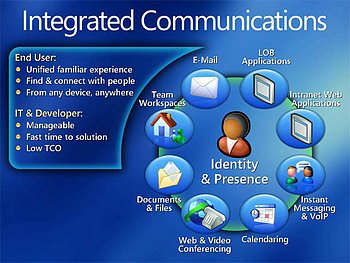If you have not been able to attend Bill Gates live announcement of Microsoft future strategy delivered yesterday morning in San Francisco, I suggest you go give a look and ear to what he had to say (text transcript and PowerPoint available too).

Bill Gates yesterday morning in the live webcast from San Francisco
Microsoft vision on the future of online collaboration is right on target, and their comprehensive understanding of how the different components of collaboration need to fit together is impressive.

The integrated communication platform that Microsoft is gradually building brings together everything from instant messaging and presence awareness to web conferencing, interaction with mobile phones, PDAs, VoIP and video.
Not only, Microsoft finally understands the importance of embedding collaboration hook and presence awareness info within all apps, without requiring this vital information to be confined to a separate application.
Microsoft wants also to extend the reach of its live communication options to bridge into non-real time apps so that from SharePoint workspaces or Outlook-based exchanges there is a unique continuum allowing to scale-up the richness and immediacy of communication at any time and with maximum ease.
This is indeed the future and I am glad Microsoft is going to be part of this.
Yesterday, Microsoft gave the announcement for three powerful new products, starting with the Microsoft Live Communication Server, continuining with the new Microsoft Live Meeting 2005 (web conferencing and live group collaboration) and finishing with the newest kid on the block: Office Communicator 2005 (presence, IM, audio and video conferencing).

Anoop Gupta Microsoft Corporate Vice President. Real-Time Collaboration Business Unit
These are quite impressive new releases integrating state of the art functionality, new features and in some cases great UI design and consequent ease of use.
I have been testing the new MSLM 2005 during this week and I hope I will be able to get beyond Microsoft tight NDA policies and report more in detail to you what I haveb been finding out.
But, in my humble opinion, two critical things were crucially missing from Bill's excellent presentation:
1) Identity
2) The human component in successful colaboration
1) Identity.
Though Bill clearly showed that at the center of his integrated collaboration platform framework "Identity" and "Presence" had a uniquely central and pivotal role, he never mentioned how and when identity would be tackled as one of the most critical items in our road toward effective online work.

What is referenced today for identity, is nothing more than a combination of username/password or a prsence in the company LDAP directory. But I know well, how popular are those usernames and password when the moment comes that you need someone to take over you at your PC.
So, not only identity as we have it today is nothing but a mask, a facade behind which we can't really see, and secondly we keep making the same great error of mixing up identity authentication with privileges, which to ambiguity adds open doors to fraud.
This is why we have a situation where in real-time online meetings we are certifying a login/username/password but we are IN NO WAY sure of who the person behind that username/password REALLY is. Aren't we?
This is where we need to put more attention to without in any way needing to compromise our own personal privacy.
2) The human component in successful collaboration. Effective
online collaboration is not the direct result of simply adding/buying/deploying new technology.
As enterprises gradually decentralize their operations and new networked business ecosystems start to find their way into profitable niche marketplaces, virtual, networked business teams gradually emerge as the wave of the future.
To be successful, virtual, networked business teams need a strategic framework in which to operate. They also need good planning and in-depth project analysis, effective and accessible technologies, constant coaching, systematic fine-tuning, feedback processes and the full understanding that their success cannot be determined by a pre-designated set of communication
technologies by itself.
But, until now, projects supported by virtual business teams have not been brought back major successes. Virtual teams are having major problems and managing their progress has been a superlative challenge for most.
Organizations face for the first time the need to analyze and comprehend which are the key obstacles to the successful management of effective online collaborative business networks. Though the answer is not simple, the solution is to be found in examples that are closer to us than we have yet realized.
Virtual collaboration for networked business teams is a complex and challenging activity in which there are major important components to be accounted for.
Virtual business teams DO NOT operate like traditional physical teams, as their requirements reflect a whole new way of communicating, working collaboratively, sharing information and mutually supporting other team members. The new technologies and approaches required to achieve this are completely alien to most of our present organizational culture. And this is why they fail.
Cooperative processes are not the automatic results of implementing collaborative, real-time communication technologies, but the result of a carefully designed and systematically maintained virtual team development plan.
For those of you who have already exposed themselves to the positive advantages made available by the use of cutting-edge communication and collaboration technologies, this should sound as a familiar melody.
How many times have you been witness to technologically-based collaboration projects that have miserably failed. Why is there so much disjoint between technology potential and the productive use that business team members make of them?
If the solution is not in the technology enabling such networked business teams to easily interoperate, where is it then?
To answer this question, I strongly invite you to read the Manifesto I have just published together with Ken Thompson:
"Bioteaming, a Manifesto for Networked Business Teams : a conceptual framework for the successful management of physically distributed collaborative business networks and highly mobile virtual teams."
What do you think?
[ Read more ]



